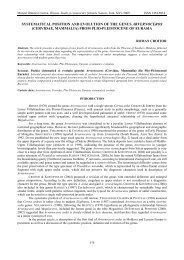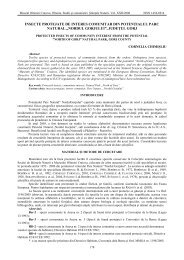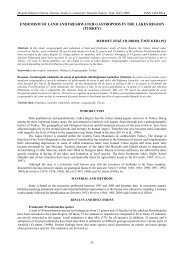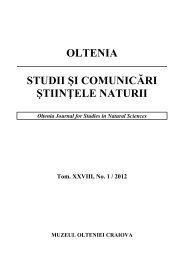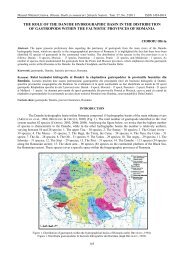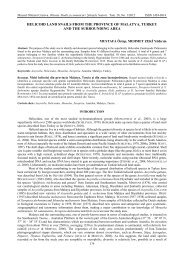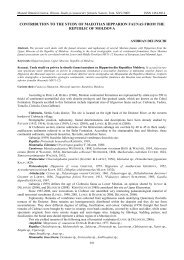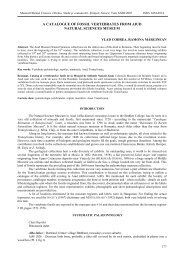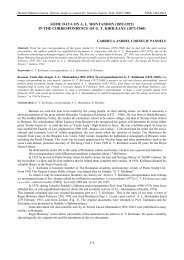110 years from the birth of the distinguished biologist prof. acad ...
110 years from the birth of the distinguished biologist prof. acad ...
110 years from the birth of the distinguished biologist prof. acad ...
You also want an ePaper? Increase the reach of your titles
YUMPU automatically turns print PDFs into web optimized ePapers that Google loves.
Muzeul Olteniei Craiova. Oltenia. Studii i comunicri. tiinele Naturii, Tom XXIII/2007 ISSN 1454-6914<br />
<strong>110</strong> YEARS FROM THE BIRTH OF THE DISTINGUISHED BIOLOGIST<br />
PROF. ACAD. EMIL POP (1897 – 2007)<br />
TEFAN NEGREA, ALEXANDRINA NEGREA<br />
Abstract. Short description <strong>of</strong> <strong>the</strong> life and work <strong>of</strong> <strong>the</strong> Pr<strong>of</strong>essor Academician Emil Pop (13 April 1897 – 14 July 1974),<br />
<strong>distinguished</strong> botanist, founder <strong>of</strong> <strong>the</strong> Romanian Paleopalinology and <strong>of</strong> <strong>the</strong> Romanian schools <strong>of</strong> Fit<strong>of</strong>iziology, Cit<strong>of</strong>iziology,<br />
Fitogeography and Palinology, a conservationist and a brilliant science historian <strong>from</strong> our country – at <strong>110</strong> <strong>years</strong> <strong>from</strong> his <strong>birth</strong>.<br />
Key words: Emil Pop, life and work, <strong>110</strong> <strong>years</strong> <strong>from</strong> <strong>the</strong> <strong>birth</strong><br />
Rezumat. <strong>110</strong> ani de la naterea eminentului biolog Pr<strong>of</strong>. Acad. Emil Pop (1897 – 2007). Articolul conine o succinta prezentare<br />
a vieii i operei pr<strong>of</strong>esorului Emil Pop (13 aprilie 1897-14 iulie 1974), eminent botanist, fondator al paleopalinologiei româneti,<br />
creatorul colilor romaneti de fit<strong>of</strong>iziologie, cit<strong>of</strong>iziologie i palinologie, protagonist al ocrotirii naturii i strlucit istoric al tiinei -<br />
cu prilejul împlinirii a <strong>110</strong> ani de la natere.<br />
Cuvinte cheie: Emil Pop, viata i opera, <strong>110</strong> ani de la natere<br />
In 1997, <strong>the</strong> Romanian Academy paid homage in a festivity to <strong>the</strong> <strong>distinguished</strong> botanist Emil Pop, founder <strong>of</strong><br />
<strong>the</strong> Romanian Paleopalinology and <strong>of</strong> <strong>the</strong> Romanian schools <strong>of</strong> Fit<strong>of</strong>iziology, Cit<strong>of</strong>iziology, Fitogeography and<br />
Palinology, a conservationist and a brilliant science historian <strong>from</strong> our country. Since <strong>the</strong>n a decade passed. Due to <strong>the</strong><br />
importance <strong>of</strong> his <strong>acad</strong>emic, didactic and scientific work, we regard as welcome a short description <strong>of</strong> <strong>the</strong> life and<br />
achievements <strong>of</strong> <strong>the</strong> famous Romanian scientist.<br />
Emil Pop was born at 13 April 1897 in Bucerdea Vinoas <strong>from</strong> <strong>the</strong> Alba county. His fa<strong>the</strong>r, Antoniu Pop and<br />
his mo<strong>the</strong>r, Lucreia, were peasants with progressive views, deeply involved into <strong>the</strong> village life and <strong>the</strong> scientist was<br />
proud <strong>of</strong> <strong>the</strong>m. Between 1903 and 1907, he graduated <strong>the</strong> first four classes at <strong>the</strong> romano-catholic primary school <strong>of</strong><br />
Hungarian language <strong>from</strong> Alba Iulia, <strong>the</strong>n, between 1907 and 1912, he followed five classes at <strong>the</strong> romano-catholic<br />
high-school <strong>of</strong> Hungarian language <strong>from</strong> <strong>the</strong> same town. He followed <strong>the</strong> last three high-school classes at <strong>the</strong> famous<br />
Romanian orthodox “Andrei aguna” high-school <strong>from</strong> Braov where he graduated in 1915. After three <strong>years</strong> <strong>of</strong><br />
teological studies, he graduated in 1918 <strong>the</strong> “Andreian Seminary” <strong>from</strong> Sibiu, while after his marriage with <strong>the</strong> Natural<br />
Sciences Pr<strong>of</strong>essor Florica Silvia Ioana Oan, in 1922, he was ordained a priest. However, destiny, but especially his<br />
obvious passion for <strong>the</strong> study <strong>of</strong> nature, stopped him <strong>from</strong> embracing a priestly career. This passion made him to enter<br />
in <strong>the</strong> next year, in 1919, <strong>the</strong> newly founded Science Faculty <strong>of</strong> <strong>the</strong> Upper Dacia University <strong>from</strong> Cluj. Noted by his<br />
pr<strong>of</strong>essors for his interest in Botanic, <strong>the</strong> student Emil Pop was, between 1920 and 1922, a preparatory at <strong>the</strong> Botanic<br />
Institute for <strong>the</strong> course <strong>of</strong> Botanic Systematics for <strong>the</strong> pharmacy candidates. Also, in 1920, he began his collaboration<br />
with <strong>the</strong> Pr<strong>of</strong>essor Alexandru Borza for <strong>the</strong> first “current botanic bibliography”, published in <strong>the</strong> Bulletin <strong>of</strong> <strong>the</strong> Cluj<br />
Botanical Garden – a collaboration which was to last until 1948.<br />
In 1922, he graduated his bachelor degree with <strong>the</strong> speciality “Geography-Botanic”, being considered “<strong>the</strong> first<br />
bachelor degree in Natural Sciences <strong>of</strong> <strong>the</strong> young Science Faculty <strong>from</strong> Cluj” (Sidonia Puiu, 1999). The original <strong>the</strong>sis,<br />
for which he obtained his diploma <strong>of</strong> “bachelor degree in Natural Sciences with distinction”, elaborated under <strong>the</strong><br />
supervision <strong>of</strong> <strong>the</strong> scientist Al. Borza, and named “Romanian peat-bogs <strong>from</strong> a botanical point-<strong>of</strong>-view”, already<br />
foretold <strong>the</strong> excellent specialist with essential contributions to <strong>the</strong> study <strong>of</strong> this type <strong>of</strong> ecosystem <strong>from</strong> Romania.<br />
After his bachelor degree, at 1 October 1922, Emil Pop was appointed assistant at <strong>the</strong> Science Faculty <strong>from</strong><br />
Cluj and a year later, assistant at <strong>the</strong> Botanic Ca<strong>the</strong>dra <strong>from</strong> <strong>the</strong> Academy <strong>of</strong> Agronomic High Studies <strong>from</strong> <strong>the</strong> same<br />
town. Between, 1923 and 1925, <strong>the</strong> young Emil Pop travelled <strong>the</strong> entire country collecting a rich floristic and pale<strong>of</strong>loristic<br />
material. In <strong>the</strong> 154 field trips (see S. Puiu, 1999) he investigated especially <strong>the</strong> marshes and <strong>the</strong> forests <strong>from</strong><br />
Bucovina, Maramure, Apuseni Mountains, Oltului Valley and Bucegi Mountains but without neglecting <strong>the</strong><br />
surroundings <strong>of</strong> Cluj.<br />
Starting <strong>from</strong> 1925, Emil Pop became one <strong>of</strong> <strong>the</strong> lecturers <strong>of</strong> <strong>the</strong> “Extensiunea universitar” Association which<br />
had proposed a cultural campaign through conferences and publications, and <strong>of</strong> <strong>the</strong> ASTRA who switched its centre<br />
<strong>from</strong> Sibiu to Cluj; two <strong>years</strong> later, in 1927, he was elected member <strong>of</strong> ASTRA, where, up to 1946, he will be a vicesecretary<br />
<strong>of</strong> <strong>the</strong> Natural Sciences section.<br />
The <strong>years</strong> passed and, despite his remarkable scientific activity, <strong>the</strong>re was no appointment for him at <strong>the</strong><br />
Science Faculty. This is why, in 1926, he passed his capacity exam for high-school teachers with <strong>the</strong> speciality Natural<br />
Sciences (main) and Geography (secondary). Taking <strong>the</strong> first place on <strong>the</strong> country, he was appointed secondary<br />
pr<strong>of</strong>essor at <strong>the</strong> Boys High-School “Titu Maiorescu” <strong>from</strong> Aiud. But very soon, he was moved, by ministerial decision,<br />
at <strong>the</strong> Cluj University. Here, at 1 November 1926, he was appointed lecturer (firstly suplinitor, titular <strong>from</strong> 1930, <strong>the</strong>n<br />
definitively <strong>from</strong> 1932) at <strong>the</strong> Botanical Institute <strong>of</strong> <strong>the</strong> Science Faculty – a place he held for 13 <strong>years</strong>, until 1939.<br />
During <strong>the</strong> first 8 <strong>years</strong> (1926 – 1936), he also was a pr<strong>of</strong>essor in high-schools <strong>from</strong> Alba Iulia, Aiud and <strong>the</strong> Pedagogic<br />
Seminary <strong>from</strong> Cluj.<br />
251
TEFAN NEGREA<br />
ALEXANDRINA NEGREA<br />
1928 is linked with two major events in <strong>the</strong> life <strong>of</strong> Emil Pop: <strong>the</strong> organization <strong>of</strong> <strong>the</strong> first Naturalists Congress<br />
<strong>from</strong> Romania (Cluj, 18 – 22 April), as a vice-secretary and editor <strong>of</strong> <strong>the</strong> papers <strong>of</strong> this congress (toge<strong>the</strong>r with Al.<br />
Borza) and <strong>the</strong> defending <strong>of</strong> his Ph.D., under <strong>the</strong> supervision <strong>of</strong> <strong>the</strong> same pr<strong>of</strong>essor. His <strong>the</strong>sis, named “Pollen analysis<br />
<strong>from</strong> peat-bogs in Eastern Carpathians (Dorna-Lucina)” was <strong>distinguished</strong> with “magna cum laude”, while Emil<br />
Racovi proposed it “without any doubt” for <strong>the</strong> prize “Gheorghe Lazr”, being “one <strong>of</strong> <strong>the</strong> best natural sciences<br />
papers, written after <strong>the</strong> war, in our country”.<br />
In August 1930, Emil Pop travelled in Austria, Switzerland, France, Belgium and England, at Cambridge,<br />
where he presented at <strong>the</strong> V th International Botanical Congress <strong>the</strong> work “Post-glacial succession <strong>of</strong> <strong>the</strong> forests <strong>from</strong><br />
Romania in comparison with those <strong>from</strong> Central and Nor<strong>the</strong>rn Europe”. 1932 was an important year in Emil Pop’s<br />
career: he held <strong>the</strong> first course <strong>of</strong> Geobotanics <strong>from</strong> our country at <strong>the</strong> Science Faculty <strong>from</strong> Cluj; he was elected<br />
member <strong>of</strong> <strong>the</strong> International Association for <strong>the</strong> Study <strong>of</strong> <strong>the</strong> Quaternary, <strong>from</strong> Vienna; he defended his docency in<br />
botanical geography, named “Contributions to <strong>the</strong> history <strong>of</strong> <strong>the</strong> Quaternary vegetation <strong>from</strong> Transsylvania”. From this<br />
year up to his retirement (1967) he had an intense and rich didactic activity with many courses underlining his erudition<br />
and his passion for botanical disciplines: plant systematics, Romanian Quaternary flora and vegetation, Earth flora and<br />
vegetation, genetic and historical fitogeography, plant anatomy and fiziology, general botanic, botanic geography and<br />
many o<strong>the</strong>rs.<br />
In <strong>the</strong> same time, Emil Pop began studies on <strong>the</strong> Romanian flora, mainly studies <strong>of</strong> paleobotanics. With this<br />
goal, he made hundreds <strong>of</strong> field travels, collecting a rich material which he carefully studied and publishing numerous<br />
papers. Also, when he travelled in Europe at various congresses and symposiums in order to present his results, he went<br />
through <strong>the</strong> museum laboratories to study fossil plants coming <strong>from</strong> our country or <strong>from</strong> o<strong>the</strong>r parts <strong>of</strong> <strong>the</strong> continent.<br />
His last travel took place in 1972 in Germany, at Heidelberg and Tübingen, where he held a conference about <strong>the</strong> peatbogs<br />
<strong>of</strong> Romania and established, with <strong>the</strong> help <strong>of</strong> Pr<strong>of</strong>. B. Frenzel, <strong>the</strong> age <strong>of</strong> <strong>the</strong> peat-bogs <strong>from</strong> us by <strong>the</strong> C 14 method<br />
(details about Emil Pop’s researches in <strong>the</strong> “Cronology” made by S. Puiu, 1999, pp. 67-93).<br />
Also <strong>from</strong> 1932, Emil Pop showed a special interest for <strong>the</strong> science history, being a member, right <strong>from</strong> its<br />
founding, <strong>of</strong> <strong>the</strong> “Romanian national group for <strong>the</strong> Science History”, made up by doctors, naturalists, physicians, etc., a<br />
group affiliated to <strong>the</strong> International Union <strong>of</strong> Science History <strong>from</strong> Paris. Beginning <strong>from</strong> this year and until his death,<br />
he was preoccupied by <strong>the</strong> problems <strong>of</strong> <strong>the</strong> history <strong>of</strong> biology. A pro<strong>of</strong> <strong>of</strong> this, are <strong>the</strong> more than a hundred <strong>of</strong> studies<br />
concerning <strong>the</strong> life and <strong>the</strong> work <strong>of</strong> important naturalists or o<strong>the</strong>r aspects <strong>of</strong> <strong>the</strong> history <strong>of</strong> botanics and o<strong>the</strong>r biological<br />
disciplines. Worth remembering, in 1961, Emil Pop was elected correspondent member, and <strong>from</strong> 1963 a full member,<br />
<strong>of</strong> <strong>the</strong> “Académie Internationale d’Histoire des Sciences” (AIHS). In <strong>the</strong> next year, he was elected a member in <strong>the</strong><br />
Romanian Committee for <strong>the</strong> Science History and Philosophy (CRIFS), Mihai Ralea being <strong>the</strong> president.<br />
In 1939, Emil Pop was appointed titulary pr<strong>of</strong>essor at <strong>the</strong> Ca<strong>the</strong>dra <strong>of</strong> Plant Physiology <strong>of</strong> <strong>the</strong> Science Faculty<br />
<strong>from</strong> Cluj. He opened his course with a memorable speech, “The old age and <strong>the</strong> death <strong>of</strong> plants”, published in 1940 – “<br />
a true pedagogic, scientific and original document, a syn<strong>the</strong>sis subject <strong>of</strong> <strong>the</strong> biologic sciences for <strong>the</strong> philosophical<br />
meditation on life” (S. Puiu, 1999).<br />
During <strong>the</strong> war (1940 – 1945), E. Pop followed <strong>the</strong> Science Faculty into <strong>the</strong> refuge at Timioara, where he held<br />
his course and <strong>the</strong> function <strong>of</strong> vice-dean (1942-1944). In 1943 he was invited in Germany where he held a cycle <strong>of</strong><br />
conferences at numerous universities and visited various institutes and laboratories <strong>from</strong> Berlin, Halle, Vienna and Graz<br />
and o<strong>the</strong>r towns. It was a good occasion to establish direct relationships and to work with specialists in plant<br />
physiology, fitocenology and palinology.<br />
Returning <strong>from</strong> <strong>the</strong> refuge, in 1945, <strong>the</strong> Cluj University and its pr<strong>of</strong>essors had difficult times: drought, famine,<br />
social upheavals. In 1946, Emil Pop declined <strong>the</strong> position <strong>of</strong> plant physiology pr<strong>of</strong>essor at <strong>the</strong> Science Faculty <strong>from</strong><br />
Bucharest, being totally linked to <strong>the</strong> Cluj Faculty. In 1947, he was strongly affected by <strong>the</strong> death in poverty and<br />
depression <strong>of</strong> <strong>the</strong> scientist Emil Racovi, his scientific and spiritual model. The next year, came with <strong>the</strong> education<br />
reform and his appointment as a director <strong>of</strong> <strong>the</strong> Botanical Garden <strong>from</strong> Cluj. But <strong>the</strong> hardest blow came in 1950, when<br />
his course <strong>of</strong> Plant Physiology was criticised by Al. Bogdan and Andrei Roth <strong>from</strong> <strong>the</strong> “Marxism ca<strong>the</strong>dra” <strong>of</strong> <strong>the</strong><br />
University in front <strong>of</strong> <strong>the</strong> didactic and technical staff. He was especially accused <strong>of</strong> lacking <strong>the</strong> knowledge <strong>of</strong> <strong>the</strong><br />
“Marxist science”, not using <strong>the</strong> soviet bibliography but using excessively <strong>the</strong> western one and a low politic and<br />
ideological level.<br />
An important moment in his scientific career was his election, in 1955, as a full member <strong>of</strong> <strong>the</strong> Academy <strong>of</strong><br />
P.R. <strong>of</strong> Romania; 8 <strong>years</strong> later, in 1963, he was elected president <strong>of</strong> <strong>the</strong> Biological Sciences Section – a function he held<br />
up to his death. With this occasion, he held a memorable “reception speech”, named “History <strong>of</strong> <strong>the</strong> Romanian forests”<br />
written both with scientific objectivity, erudition and love for nature and country. Worth remembering, also as a<br />
member <strong>of</strong> <strong>the</strong> Academy, he was <strong>the</strong> active president <strong>of</strong> <strong>the</strong> Natural Monuments Board. Also within <strong>the</strong> Academy, Emil<br />
Pop led <strong>the</strong> Centre for Biological Research <strong>from</strong> Cluj, transformed by him in <strong>the</strong> Institute <strong>of</strong> Biology <strong>from</strong> Cluj by<br />
uniting some research collectives which worked separately; this is <strong>the</strong> reason why he can be regarded as <strong>the</strong> founder <strong>of</strong><br />
this institute. In 1964, he was awarded with <strong>the</strong> title <strong>of</strong> “Emeritus Scientist” and in 1966 with “Scientific Merit class. I”.<br />
In 1973, he was elected honorary member <strong>of</strong> <strong>the</strong> Hungarian Science Academy.<br />
The last two decades <strong>of</strong> his life (1954 – 1974) were <strong>the</strong> richest ones <strong>from</strong> a scientific point <strong>of</strong> view. In this<br />
period, Emil Pop had elaborated syn<strong>the</strong>sis papers. Thus, in 1957 and 1964, he published volume I and in 1960, volume<br />
II, <strong>of</strong> <strong>the</strong> “Plant Physiology” written toge<strong>the</strong>r with N. Slgeanu, t. Péterfi and H. Chirilei. Among his scientific<br />
syn<strong>the</strong>sis papers, we note: “Botanical studies in our pet-bogs” (1954) – a work <strong>of</strong> great <strong>the</strong>oretical and practical<br />
252
Muzeul Olteniei Craiova. Oltenia. Studii i comunicri. tiinele Naturii, Tom XXIII/2007 ISSN 1454-6914<br />
importance; “Peat-bogs <strong>from</strong> Romania”(1960) – valuable monograph, <strong>the</strong> first <strong>of</strong> its kind in our country; <strong>the</strong> chapter<br />
“Vegetation” <strong>from</strong> “Geographic Monograph <strong>of</strong> P.R. <strong>of</strong> Romania”, volume I (1960); “Natural Monuments <strong>from</strong><br />
Romania”, edited toge<strong>the</strong>r with N. Slgeanu (1965); “History <strong>of</strong> <strong>the</strong> sciences <strong>from</strong> Romania – Biology”, volume edited<br />
with R. Codreanu, published posthumously (1975). Each <strong>of</strong> his syn<strong>the</strong>ses represents fundamental works for <strong>the</strong> main<br />
research directions he followed, working with passion until <strong>the</strong> end <strong>of</strong> his life.<br />
The manifold activities <strong>of</strong> Emil Pop in <strong>the</strong> biological sciences domain, resulting in original papers with a great<br />
value, made him famous both in our country and abroad. A pro<strong>of</strong> lies in his election in various <strong>acad</strong>emic societies,<br />
among which we note: International Union for <strong>the</strong> Science History (UIHS), Finnish Society for Zoology-Botanics<br />
(Helsinky), Unional Botanical Society (Sankt Petersburg), International Society for Quaternary Studies, “Leopoldina”<br />
Naturalists Academy (Halle), International Society for Peat-Bogs Studies and o<strong>the</strong>rs. This universal recognition is due<br />
to his works in <strong>the</strong> field <strong>of</strong> palinology (he is regarded as <strong>the</strong> founder <strong>of</strong> <strong>the</strong> Romanian palinology), fitogeography , citoand<br />
fit<strong>of</strong>iziology, in <strong>the</strong> field <strong>of</strong> science history and nature conservation. We should add at all <strong>the</strong>se his incontestable<br />
merit for <strong>the</strong> founding <strong>of</strong> <strong>the</strong> Institute <strong>of</strong> Biology <strong>from</strong> Cluj and master in <strong>the</strong> fields <strong>of</strong> cit<strong>of</strong>iziology, fit<strong>of</strong>iziology,<br />
fitogeography and palinology.<br />
The human Emil Pop was at <strong>the</strong> height <strong>of</strong> his scientific and didactic work. His native qualities and his moral<br />
principles learned in <strong>the</strong> high-school and <strong>the</strong> seminary made him appreciated and admired by colleagues and friends and<br />
loved like a fa<strong>the</strong>r by his scientific pupils. His humaneness, his encyclopaedic culture, was doubled by his scientific<br />
carefulness and exigency in research and by a <strong>distinguished</strong> and complete pr<strong>of</strong>essor <strong>of</strong> <strong>the</strong> Cluj University. All <strong>the</strong>se<br />
qualities, and many o<strong>the</strong>rs, were publicly emphasized at <strong>the</strong> celebration <strong>of</strong> his 60 <strong>years</strong> (13 April 1958). Here are just a<br />
few <strong>of</strong> <strong>the</strong>m: “At <strong>the</strong> ca<strong>the</strong>dra <strong>of</strong> plant fiziology he proved to be not only a worthy follower <strong>of</strong> his predecessors,<br />
Teodorescu and Grinescu, but also a creator <strong>of</strong> new ways in <strong>the</strong> Romanian science, such as <strong>the</strong> peat-bogs studies…”<br />
(Iuliu Prodan). “The gentle, luminous face, always ready to help with a kind advice, endorsed by a keen observation and<br />
endowed with a generous and infectious humour, makes <strong>the</strong> Pr<strong>of</strong>essor Emil Pop <strong>the</strong> most pleasant and complete<br />
interlocutor. You feel a real pleasure under <strong>the</strong> spell <strong>of</strong> his personality and his charming words. His love for <strong>the</strong><br />
sustained and minutely work in laboratory and in <strong>the</strong> field, serves superior scientific goals, ensuring <strong>the</strong> solid base for<br />
<strong>the</strong> achievements built with <strong>the</strong> tenacity <strong>of</strong> every-day work <strong>of</strong> our erudite Pr<strong>of</strong>essor and Academician…” (Eugen<br />
Stoicovici). “The abnegation with which he knew how to inspire his disciples with love for <strong>the</strong> research <strong>of</strong> truth, made<br />
us to always know him as a representative <strong>of</strong> firm ethical attitudes. He gave himself so much for some <strong>of</strong> us, that our<br />
gratitude cold never be expressed by <strong>the</strong> sonority <strong>of</strong> words” (N. Bocaiu). “When I bring to <strong>the</strong> scientist our homage<br />
and gratitude for <strong>the</strong> scientific works <strong>of</strong> his life, with <strong>the</strong> same high esteem and warm affection, I also think at <strong>the</strong><br />
upright, kind and helping friend on which you can always count” (V. L. Bologa). “Now on <strong>the</strong> doorway <strong>of</strong> autumn, I<br />
wish many <strong>years</strong> and works to my friend Emil Pop, <strong>the</strong> <strong>distinguished</strong> naturalist and eminent stylist.”(Lucian Blaga).<br />
“Since I had <strong>the</strong> chance to know each o<strong>the</strong>r and befriend you, I always found you reading and looking into <strong>the</strong><br />
microscope, on herbariums or travelling <strong>the</strong> country to investigate its flora. As one who closely watched your brilliant<br />
career, I can only wish you, even now when old age knocks at <strong>the</strong> door, two things: may God gives you good health to<br />
finish successfully your researches, your treaties, and especially your syn<strong>the</strong>ses; while <strong>the</strong> <strong>years</strong> to came may not<br />
diminish your health and soul harmony, so we can enjoy for a long time your wonderful humour which unwrinkled our<br />
brows so many times” (Ion Mulea). “I admire at my colleague, Academician Emil Pop, <strong>the</strong> erudition, <strong>the</strong> talent <strong>of</strong> a<br />
beautiful speech, <strong>the</strong> cult for our scientific predecessors, <strong>the</strong> patriotism and <strong>the</strong> noble passion with which he works to<br />
preserve <strong>the</strong> beauties and <strong>the</strong> natural monuments” (Gh. Ionescu-ieti).<br />
And now, in <strong>the</strong> end, what else can we add? Only that I had <strong>the</strong> happy chance to know personally <strong>the</strong> pr<strong>of</strong>essor<br />
Emil Pop in two occasions – enough to realize how true are <strong>the</strong> above mentioned remarks. The first time was in 1959,<br />
when I, toge<strong>the</strong>r with my colleague Lazr Botoneanu, asked him to make a short travel to <strong>the</strong> spring complex with<br />
relict fauna <strong>from</strong> Corbii Ciungi, which we had just discovered, in order to collect pollen samples <strong>from</strong> <strong>the</strong> peat deposit.<br />
The eminent specialist came immediately, studied <strong>the</strong> eutrophic peat and sent us <strong>the</strong> results we used in our monograph<br />
about <strong>the</strong> biology <strong>of</strong> <strong>the</strong> springs and <strong>the</strong> phreatic waters <strong>from</strong> <strong>the</strong> Romanian Plain (C. Mota, L. Botoneanu, t.<br />
Negrea, 1962). The second and last time, we met him in 1967, at <strong>the</strong> Academy, when we asked him, as president <strong>of</strong> <strong>the</strong><br />
Section <strong>of</strong> Biological Sciences, to intercede beside <strong>the</strong> Academy Publishing House which asked me to reduce by half a<br />
syn<strong>the</strong>sis regarding <strong>the</strong> parietal biocoenosis <strong>of</strong> <strong>the</strong> caves <strong>from</strong> <strong>the</strong> Banatului Mountains. After I told him that I published<br />
something in a Polish journal, he advised me to send may paper <strong>the</strong>re, as <strong>the</strong> Academy Publishing House always<br />
proposes text reductions without verifying if <strong>the</strong> text really contains surplus pages.<br />
At 70 <strong>years</strong>, on 7 April 1967, Emil Pop was once more celebrated in <strong>the</strong> Romanian Academy aula. From <strong>the</strong><br />
speech he held with this occasion, I quote this fragment: “What would I do if I’d start again, but with <strong>the</strong> experience and<br />
state <strong>of</strong> mind I have now? […]. I’m afraid I would deny none <strong>of</strong> my directions […]. If I would start again, I would like<br />
to use <strong>the</strong> same paths toward <strong>the</strong> seducing unknown to be at 70 <strong>years</strong> what I am now”. Who would have guessed that<br />
<strong>the</strong> dynamic pr<strong>of</strong>essor, who had just held at 25 th May 1967 this final course <strong>of</strong> his didactic career with <strong>the</strong> subject<br />
“Evolution <strong>of</strong> <strong>the</strong> biological sciences and especially <strong>the</strong> molecular biology”, had only 7 <strong>years</strong> to live? Barely retired at 1<br />
October 1967 at age limit and appointed consultant pr<strong>of</strong>essor without a salary, he already felt <strong>the</strong> effects <strong>of</strong> <strong>the</strong><br />
bureaucracy : for two months he did not receive nei<strong>the</strong>r salary nor pension for <strong>the</strong> reason his pension was…to high (see<br />
S. Puiu, 1999, p.89). In 1969 began <strong>the</strong> process <strong>of</strong> reorganization <strong>of</strong> <strong>the</strong> research institutions by merging and transfer<br />
<strong>from</strong> <strong>the</strong> Academy to <strong>the</strong> ministers. Emil Pop’s raport showing that a transfer <strong>of</strong> <strong>the</strong> research institutes <strong>of</strong> <strong>the</strong> Academy<br />
to <strong>the</strong> ministers would be to destroy <strong>the</strong>m, was not headed. His proposal <strong>from</strong> 26 January 1970, regarding <strong>the</strong> founding<br />
253
TEFAN NEGREA<br />
ALEXANDRINA NEGREA<br />
<strong>of</strong> an Academic Institute <strong>of</strong> Science History, with his own journal, monograph and syn<strong>the</strong>ses, was not approved also. In<br />
1973, although aware <strong>of</strong> his physical decline, he continued to lead an active life, organizing a CRIFST symposium and<br />
participating at a Palinology Symposium. In 1974, reaching 77 <strong>years</strong>, he noted <strong>the</strong> ever present tiredness at <strong>the</strong> desk, his<br />
correspondence remained un-opened and his thoughts were clouded by <strong>the</strong> fate <strong>of</strong> <strong>the</strong> Academy, lacking its research<br />
institutes, its commissions and committees. At 1 July 1974, he wrote <strong>the</strong> foreword at <strong>the</strong> last volume <strong>of</strong> <strong>the</strong> S. R. <strong>of</strong><br />
Romania Flora, underlining this is <strong>the</strong> first Flora finished in Europe; that it was started by Tr. Svulescu, coordinated by<br />
E. I. Nyárády and finished by him. At 7 July, he made <strong>the</strong> last travel in <strong>the</strong> Apuseni Mountains, noted in his field notebook.<br />
A week later, at 14 July 1974, at 9 AM., Emil Pop was knocked down on his desk by a brain vascular accident. At<br />
19 December 1974, he was followed in <strong>the</strong> world beyond by Florica Pop, <strong>the</strong> one who was in <strong>the</strong>ir harmonious life “<strong>the</strong><br />
hope <strong>of</strong> hopes” (S. Puiu, 1999, p.96).<br />
I am ending <strong>the</strong> short presentation <strong>of</strong> <strong>the</strong> life and work <strong>of</strong> Emil Pop, emphasizing that posterity remembered<br />
him as an important, au<strong>the</strong>ntic scientist among <strong>the</strong> gallery <strong>of</strong> great <strong>biologist</strong>s given by Romania to <strong>the</strong> entire world.<br />
REFERENCES<br />
ARDELEAN A. & SORAN V. (coordinators). 1999. Emil Pop – o sut de ani de la natere (1897 – 1997). Edit. Risoprint.<br />
Cluj-Napoca: 322 p.<br />
MOTA C., BOTONEANU L., NEGREA T. 1962. Cercetri asupra biologiei izvoarelor i apelor freatice din partea<br />
central a Câmpiei Române. Editura Academiei R. P. Române. Bucureti. 366 p.<br />
POP E. & CODREANU R (coordinators and authors). 1975. Biologia in : t. Milcu (coordinator), Istoria tiinelor în<br />
România, series edited by CRIFS – Academia R. S. România. Editura Academiei, Bucureti. 295 p.<br />
PUIU SIDONIA. 1999. Viaa i opera <strong>acad</strong>emicianului Emil Pop in: A. Ardelean & V. Soran (coordinators), Emil Pop - o<br />
sut de ani de la natere (1897 – 1997). Edit. Risoprint, Cluj-Napoca: 63-169.<br />
Stefan Negrea and Alexandrina Negrea<br />
Spelological Institute "Emil Racovitza" <strong>of</strong> Romanian Academy<br />
Calea 13 Septembrie nr. 13, RO-050711 Bucuresti, Romania<br />
e-mail: stnegrea@yahoo.com<br />
254



